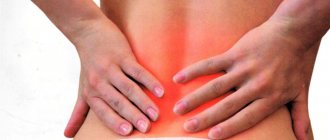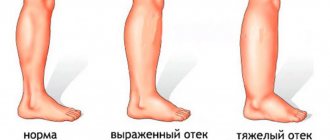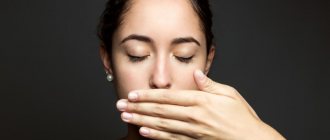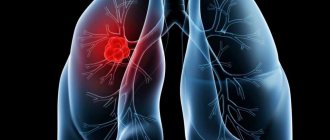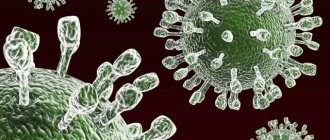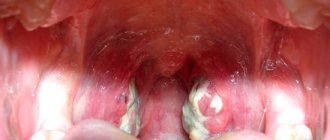28.06.2017
Head and neck diseases | Ears
The Eustachian tube (auditory tube) is a canal 3–4 cm long and 2 mm in diameter that connects the nasopharynx with the middle ear. The canal got its name from Bartolomeo Eustachio, an Italian physician and anatomist of the 16th century.
The presence of this channel, a conductor of air from the pharynx to the middle ear cavity, ensures equal pressure on both sides of the eardrum, resulting in good sound conduction. Otherwise, given the existence of a pressure difference between the outside and the inside, the signal from the eardrum to the middle and inner ear would be transmitted with great distortion.
What is eustachitis?
Eustachitis (tubootitis from the Latin tuba - tube) is an inflammation of the mucous membrane of the Eustachian tube and the tympanic cavity. The disease is divided into several main types: acute, chronic or bilateral eustachitis. Eustachitis can be recognized independently - hearing deteriorates, noises are heard, and headaches appear.
The auditory tube is an organ connecting the middle ear and the initial part of the digestive tract and respiratory tract (pharynx).
It allows you to normalize air exchange, remove accumulated fluid and protect against infection. But sometimes, under the influence of external factors, protective functions fail, as a result of which inflammatory processes occur in the Eustachian tube.
How is tubootitis diagnosed?
An otolaryngologist makes a diagnosis of acute or chronic inflammation of the auditory tube based on:
- Subjective patient complaints and medical history.
- Visual inspection.
- Data obtained during otoscopy, microotoscopy, video otoscopy, endoscopic examination of the nasopharynx.
- Data obtained from tympanometry, audiometry, and the study of hearing with tuning forks.
- Laboratory testing of a swab from the ear, nose or throat.
- Allergy tests (if allergic tubo-otitis is suspected).
- Computed tomography of the temporal bones, paranasal sinuses and nasopharynx.
Causes of eustachitis in adults
The causes and risk factors causing eustachitis are as follows:
- chronic or newly formed pathologies that interfere with normal air circulation (deviated septum, recently appeared tumors in the nose or enlarged ears);
- complications after allergic diseases;
- fungal, bacterial infections;
- chronic and acute diseases of the nasopharynx or respiratory tract (rhinitis, sinusitis);
- consequences of sore throat, flu, acute forms of acute respiratory infections and acute respiratory viral infections in adults;
- polyps.
These reasons lead to the development of eustachitis. Inflammation of the mucous membrane of the Eustachian tube can lead to serious consequences. And the acute form of the disease develops into chronic or turns into bilateral eustachitis.
Professional eustachitis.
The disease occurs in people who, due to their profession, are forced to frequently experience pressure changes. Because of this, the lining of the Eustachian tube is damaged, and inflammatory processes begin. These are divers, hang gliders, swimmers, and pilots.
In addition, the disease can also be caused by injury, ear injury or as a result of the consequences of surgery.
Tubootitis in children
A child's ear canal is shorter and smoother than an adult's. Thanks to this, bacteria and viruses easily penetrate into the middle ear cavity.
Clinical manifestations of pathology in children are in many ways similar to those in adults:
- Cracking in ears
- Congestion of the ears and nose,
- Hearing loss
- Swelling and hyperemia of the auricle,
- The appearance of numerous bubbles in the external auditory canal.
- Restoring hearing during coughing, sneezing, swallowing.
In children, acute tubo-otitis often manifests itself with fever, chills and painful sensations in the ears.
Development of disease in the eustachian tube
Due to the structural features of the auditory tube in adults, and it is quite narrow (only a few millimeters), during inflammatory processes its patency decreases even more.
The opening of the Eustachian tube narrows so much that air practically stops flowing into the tympanic sinus, and the remaining air is sucked in. Because of this, the pressure decreases and the structure of the eardrum changes, as if it is retracted. These changes are accompanied by significant hearing loss, congestion and noise.
Physiology of the process of occurrence of tubootitis
The middle ear is located in the temporal bone, between the external auditory canal and its internal section. It has two functional components - the tympanic cavity and the auditory (Eustachian) tube. The auditory tube connects the tympanic cavity with the nasopharynx, balances the pressure in the cavities of the middle ear, and participates in the functioning of the entire auditory system. It has a small diameter - approximately 2 mm. When the body becomes infected, the mucous membrane of the middle ear becomes inflamed, and the lumen of the auditory tube decreases. As a result, ventilation processes are disrupted - air passes into the tympanic cavity with difficulty or does not enter at all. Due to a long-term lack of air exchange and disruption of the natural drainage function of the auditory tube (the natural secretion secreted by the glands of the mucous membrane of the middle ear is normally evacuated into the nasopharynx through the auditory tube), stagnation of fluid occurs in the middle ear, which disrupts the normal functioning of the auditory system and is dangerous with the risk of developing infectious process in the tympanic cavity.
Symptoms of eustachitis
Symptoms of acute eustachitis in adults:
- increased body temperature;
- headaches and heaviness;
- ear congestion and periodic noises;
- temporary hearing loss that may disappear with swallowing or yawning;
- pain in the ear of varying intensity;
- Inflammation of the eustachian tube can cause a sensation of fluid transfusion. It manifests itself most clearly when the position of the head changes;
The symptoms of chronic eustachitis practically do not differ from the acute disease.
If the inflammatory process in the eustachian tube occurs for a long time and the functionality of the auditory tube is not restored, this is chronic eustachitis.
Inflammation of the Eustachian tube in this form is less painful than in acute form. If the disease is not recognized and treated in time, it can lead to complete hearing loss. By paying attention to the first signs of eustachitis in time, you can avoid serious complications and further damage to the mucous membrane of the Eustachian tube.
Symptoms and first signs
Depending on the causative factor, eustachitis can be acute or chronic. Symptoms will also vary.
Acute inflammation of the Eustachian tube often develops a few days after influenza, acute respiratory illness, or against the background of exacerbation of allergic rhinitis and sore throat. In all these conditions, reactive changes occur in the mucous membrane of the pharynx and involve the lymphoid tissue of the upper respiratory tract (tonsils). When the process reaches the pharyngeal opening of the Eustachian tube, it usually spreads to its lumen, causing swelling and blockage of the tube.
Chronic eustachitis usually occurs in the presence of chronic foci of inflammation in the upper respiratory tract, as well as due to non-inflammatory causes (covering the pharyngeal opening of the pipe, barotrauma).
The main complaints with eustachitis are:
- A feeling of stuffiness in the ear - occurs due to the retraction of the eardrum (after air from the nasopharynx stops entering the middle ear, a vacuum is created there).
- Hearing loss – a retracted eardrum does not conduct sound well to the inner ear. It is characteristic that hearing acuity with eustachitis is variable. The more liquid, the worse the sound conductivity. When you change the position of your head, the fluid in the tympanic cavity moves, and your hearing improves. Also, hearing can be temporarily restored after sneezing or blowing your nose, which causes the auditory tube to blow through.
- Autophony is the audibility of one’s own voice in the affected ear (“voice radiates into the ear”). This phenomenon is due to the fact that the fluid accumulated in the tympanic cavity is a good resonator for one’s own voice. In addition, with a gaping eustachian tube, vibrations of the vocal cords can penetrate it and reach the membrane, which traps them from the inside. Autophony decreases if you breathe through your mouth (this covers the pharyngeal opening of the Eustachian tube), take a horizontal position or lower your head between your knees (blood flow causes thickening of the mucous membrane, a decrease in the lumen of the tube and sticking of its walls).
- Tinnitus develops due to self-listening of processes occurring in the middle ear.
- A feeling of heaviness in the head is caused by oxygen starvation of the brain, which occurs when nasal breathing is disrupted. There are several explanations for this. Gas exchange occurs in the nasal cavity, and part of the inhaled oxygen is absorbed into the blood vessels of the nasal cavity. In addition, the stream of inhaled air is so powerful that it causes fluctuations in cerebral pressure (reflex constriction and dilation of blood vessels), promoting the movement of cerebral fluid. When you have a runny nose, the entire surface of the nasal cavity ceases to participate in gas exchange, and the body (especially the brain) receives less oxygen, and the lack of nasal breathing slows down the movement of brain fluid. This is what explains lethargy during a runny nose.
- The sensation of iridescent fluid in the ear when turning the head occurs in cases where fluid has accumulated in the tympanic cavity.
Acute pain occurs if the cause of inflammation of the Eustachian tube is barotrauma.
The general condition of eustachitis suffers little; body temperature is usually normal or subfebrile (up to 37.5°C). If the main cause of eustachitis is an acute infectious disease, then the appearance of fever, symptoms of intoxication of the body (nausea, vomiting, poor health, pain in muscles, joints) and typical signs characteristic of a particular disease (true croup in diphtheria, Filatov's spots in measles and others).
After the symptoms of rhinitis, laryngitis or sinusitis disappear, the function of the Eustachian tube is restored and the symptoms of eustachitis disappear. If the cause of eustachitis affects the mucous membrane for too long, then the inflammation of the Eustachian tube takes a protracted course (symptoms persist from 3 to 12 months) or becomes chronic.
Complications of the disease
The patient will feel the signs of acute eustachitis immediately. But the state of chronic eustachitis can be “dormant” for a long time. Undiagnosed in time, persistent inflammation of the Eustachian tube can lead to the following serious complications:
- inflammation of the ear (otitis) of any form: purulent, serous, catarrhal;
- complete or partial hearing loss;
- complete disruption of the patency of the auditory tube and scarring of the mucous membrane of the Eustachian tube.
Purulent processes in the Eustachian tube.
Appear during complications of inflammation in the Eustachian tube, developing into otitis media. Purulent otitis is manifested by severe pain in the ear, lumbago and fever. May develop during chronic eustachitis.
Causes of pathology
Pathology has two forms: acute eustachitis and chronic. It has been proven that obstruction of the Eustachian tube occurs due to blockage of the nasopharyngeal orifice. A similar condition is provoked by adenoids and hypertrophy of the nasal concha (its lower part).
What is tubootitis? The first stage of catarrhal otitis. The risk group includes newborn children. Therefore, every mother should know what tubo-otitis is. This pathology causes frequent otitis of the purulent and adhesive type. It leads to permanent hearing loss. It is known that the disease is a complication not only of chronic diseases, but also of anatomical disorders. Among them:
- Deviated nasal septum
- Rhinitis
- Adenoids
- Polyps
- Sinusitis
Inflammation of the auditory tube is caused by the following pathogens:
- Staphylococcus
- Streptococci
- Pneumococci
- Protozoa
If the pathology is provoked by allergic agents, a diagnosis of allergic eustachitis is made.
Diagnostics
An otolaryngologist should diagnose and treat the disease. There are several methods for recognizing inflammation of the Eustachian tube:
- examination of the patient using otoscopy. The study will allow you to notice inflammation of the Eustachian tube during the initial examination;
- computer, tone or voice measurement of hearing sensitivity is carried out;
- Ultrasound and MRI. Allows a more thorough examination of the opening of the eustachian tube, especially if there is a suspicion of tissue adhesions;
- taking smears from the ear cavity and nasopharynx (will also help identify bilateral eustachitis);
- If the patient is prone to allergies, the level of immunoglobulin E is examined.
Eustachitis should be treated under the supervision of a physician. Only a specialist will be able to prescribe the correct course of medication and tests, depending on the type of disease of the auditory tube. When starting to treat eustachitis, it is first necessary to eliminate the signs that contributed to the development of the disease.
Diagnosis
Sometimes it is not easy to determine the disease by symptoms and you have to go to the hospital for diagnosis. To identify tubo-otitis in a patient and determine the causes of its occurrence, the following diagnostic studies are performed:
- Otoscopy. The procedure is performed to carefully examine the ear cavity and identify deformation of the eardrum. Also, using otoscopy, the level of fluid that has accumulated after the onset of pathology is determined. To carry out the procedure, special small funnels or modern otoscopes are used.
- Pharyngoscopy. Inspection of the pharyngeal opening using a pharyngoscope is often performed when diagnosing eustachitis. The procedure allows you to identify the overlap of the auditory tubes by enlarged adenoids and determine the condition of the mucous membrane.
- Blood analysis. Blood tests are used to diagnose many infectious or viral diseases. With its help, it is possible to determine the level of red blood cells in the blood, the number of which increases in chronic inflammation. A blood test can also determine the cause of the pathology.
Treatment of eustachitis
Specialists can treat inflammation of the Eustachian tube using several methods: medication, surgery or homeopathic methods. Which one will be most effective is decided by the doctor for each individual patient. It all depends on how the disease progresses, whether there are prerequisites for the development of complications, the general condition of the patient and what could trigger the inflammation.
One of them is swelling of the mucous membrane of the Eustachian tube, sinuses and nasal passages. It can occur against the background of an acute respiratory viral infection or an allergic reaction. It can be relieved with vasoconstrictor nasal drops or antihistamines. If these methods do not help, hormonal drugs (adrenaline or hydrocortisone) are injected into the opening of the auditory tube using a catheter.
If the disease is accompanied by abundant mucus, which cannot be blown off and it clogs the opening of the auditory tube, then eustachitis must be treated with the help of special agents that dilute the sputum (a group of mucolytics). In more complex and aggressive cases of the disease, a proteolytic drug is administered using a catheter. It allows you to quickly clean and restore the functions of the auditory tube.
These are the most important measures in the treatment of inflammation of the Eustachian tube. Without them, further procedures are useless and will not give the desired effect. Also, when treating adults, the doctor prescribes the following:
- broad-spectrum antibiotics;
- correction and restoration of immunity;
- physiotherapeutic procedures (Ural irradiation, UHF, pneumomassage, microwave therapy);
- special exercises for the auditory tubes.
If all recommendations of the attending physician are followed, inflammation of the Eustachian tube can be treated within 7-10 days. The acute form of the disease can make the recovery process a little more difficult.
Timely treatment will help avoid chronic eustachitis and prevent the disease from becoming bilateral.
Important! Bilateral eustachitis can develop even against the background of an ordinary runny nose. Therefore, it is very important to recognize the disease in time and consult a doctor.
Treatment of eustachitis at home
Eustachitis can be treated not only with traditional methods, but also using proven traditional medicine recipes. Of course, this does not stop taking medications prescribed by the doctor, but these methods are quite capable of easing the patient’s condition. There are several recipes that will help adult patients cope with the disease:
- Squeeze juice from agave leaves and mix it with chilled boiled water in a 1:1 ratio. Using a pipette, drop 2-3 drops into each nostril 3 times a day;
- Squeeze 3-4 cloves of garlic into room temperature vegetable oil (25 g). Cover the container and let it brew for about 30 minutes. Dip a cotton swab in garlic oil and wipe the walls of the nose 3 times a day;
- A strong decoction of chamomile will help to rinse the nose. The head should be tilted to one side over the sink. Using a baby syringe, chamomile is injected deep into the nostril. Take turns. Repeat the procedure 2 times a day;
Important! These products should be used carefully, after consulting with your doctor.
Diagnosis of eustachitis
An otolaryngologist examines eustachitis. This disease is diagnosed based on medical history (the onset of the disease during or after a respiratory infection, against the background of impaired nasal breathing), patient complaints and additional studies.
In the diagnosis of eustachitis, microotoscopy and otoscopy, audiometry, determination of the patency of the Eustachian tube, hearing testing with a tuning fork, ear manometry, and acoustic impedance measurement are used.
With eustachitis, during otoscopy, a retracted eardrum is observed with the disappearance or deformation of the light cone, and with a sharply protruding process of the malleus.
In patients with eustachitis, hearing studies using a tuning fork and audiometry reveal a moderately pronounced decrease in hearing (up to 20-30 dB). This applies exclusively to the low frequency range, which is due to impaired sound conduction.
Diagnosis of the condition of the auditory tube can be carried out by objective and subjective methods. With eustachitis, an objective study of the patency of the auditory tube is carried out by blowing it. The result of this procedure is checked during otoscopy and audiometry. Reduced retraction of the eardrum and improved hearing, which are observed after purging, confirm the connection of the disease with the patency of the auditory tube.
Subjective methods include: Valsalva maneuver, Toynbee maneuver, empty throat test. The Valsalva maneuver is performed after taking a deep breath, the patient pinches his nostrils, closes his mouth and tries to exhale. When testing with an empty sip, the patient must take a forceful sip. In turn, the Toynbee test is characterized by the fact that the patient must close his nostrils while swallowing.
The results of each test are assessed according to the patient’s feelings. If the patient has good patency of the auditory tube, this will manifest itself as a “crackling” sound in the ears during the test. The patient notes squeaking, gurgling or other phenomena in the affected ear when the tube is swollen, but with some degree of patency remaining.
Determination of the antibiotic sensitivity of the microflora of eustachitis and identification of its infectious nature is carried out by bacteriological and microscopic examination of a smear from the throat. To identify underlying diseases that affect the nasopharynx, pharyngoscopy, rhinoscopy, radiography and CT scan of the paranasal sinuses are performed. Very often, it is underlying diseases that provoke the development of eustachitis. Allergy tests are performed if eustachitis is suspected of being allergic.
Prevention
Like any cold, infectious or viral disease of the hearing and respiratory organs, eustachitis in adults can be prevented and avoided by following simple recommendations:
- maintain and strengthen immunity;
- dress according to the weather;
- take seasonal vitamins and include vegetables and fruits in your diet daily;
- undergo seasonal vaccination;
- do not let colds become chronic;
- people with chronic diseases should avoid situations with changes in atmospheric pressure;
- giving up bad habits (cigarettes and alcohol);
- At the first signs of illness, consult a doctor.
Prevention of eustachitis
Since the disease in question is a complication of acute respiratory infections and diseases of the nasopharynx, prevention will consist of the following:
- seasonally take vitamin and mineral complexes to maintain immunity;
- promptly and fully treat any viral and/or inflammatory diseases of the nasopharynx/upper respiratory tract;
- during epidemics of colds, regularly rinse the nasal passages with a salt solution;
- avoid hypothermia.
Eustachitis is considered a fairly safe inflammatory disease, but only if there was a timely visit to the doctor and full treatment was carried out in strict accordance with the prescriptions of the otolaryngologist.
Tsygankova Yana Aleksandrovna, medical observer, therapist of the highest qualification category
11 total today
( 185 votes, average: 4.56 out of 5)
Otitis in children: classification, symptoms and treatment
How to get rid of nasal congestion?
Related Posts
Forecast
A timely diagnosed disease, provided that the opening of the auditory tube is able to pass air and perform its functions, takes about a week. If you conscientiously follow all the doctor’s recommendations, the prognosis for eustachitis is favorable.
If the signs of acute eustachitis are ignored, you self-medicate and do not consult a doctor, it can develop into chronic or bilateral eustachitis. Then the treatment will drag on for a long time, and it will be possible to get rid of the disease only with systematic use of medications and long-term observation by a specialist.
General information about the disease
Eustachitis or tubootitis is inflammation in the auditory tube, which connects the nasal cavity to the middle ear. There are several varieties of this disease, which are most often found in patients. Most people experience right-sided, left-sided, or bilateral eustachitis. People can also get sick from a protozoal, fungal or viral form of the disease.
Most patients with this ear pathology are children under six years of age. Moreover, in 80% of cases they suffer from a bilateral form of tubo-otitis, which is accompanied by the accumulation of fluid in the ear. This is due to the fact that at this age children suffer from colds more often than others. Also, the appearance and development of the disease is facilitated by the fact that the immune system of children is not fully formed in order to properly protect the ENT organs from inflammation. Among children, eustachitis most often appears in boys aged 1-2 years. Over time, the likelihood of the appearance and development of inflammation of the auditory tube decreases significantly.
If signs of illness appear in children or adults, you should immediately consult a doctor and begin treatment. If not treated in time, the inflammatory process will develop into a chronic form, which will lead to partial hearing loss or hearing loss.
Treatment
The treatment process includes the following significant stages:
- eliminating the causes that caused the disease and disrupted the functioning of the auditory tubes;
- hearing restoration;
- carrying out measures aimed at preventing the development of persistent hearing loss;
- If conservative treatment does not give the desired effect, it is necessary to undergo a timely surgical operation - eardrum bypass.
For conservative treatment, antibiotics, vasoconstrictors, as well as hyponsitizing agents, proteolytic enzymes, pneumomassage of the eardrums, blowing of the auditory tubes, aerosol therapy using an elastic catheter, catheterization of the auditory tubes, laser therapy, ultraviolet irradiation, and vibroacoustic therapy sessions are used.
Causes
The causative agents of the disease are most often bacteria, less often viruses, fungi, and specific microflora. In some cases, the cause of eustachitis is dysfunction of the auditory tube due to sudden changes in atmospheric pressure. This process is caused by stenosis and traumatization of the structures of this organ.
In the acute form of the disease, exogenous infection is observed through the upper respiratory tract (upper respiratory tract) due to ARVI, influenza, acute rhinitis, pharyngitis, etc. Less commonly, inflammation occurs due to edema in allergic pathologies (hay fever, allergic rhinitis).
The occurrence of the chronic form is caused by the endogenous entry of pathogens from chronic foci of infection (chronic tonsillitis, sinusitis, rhinitis). The second cause of chronic eustachitis is impaired ventilation of the Eustachian tube. This process occurs under the following conditions:
- deviated nasal septum;
- hypertrophy of the nasal concha;
- benign and malignant neoplasms of the pharynx and nose.
Signs of tubootitis
The course of otitis media is accompanied by similar symptoms in all age groups of patients, the clinical nature of which is determined by the form of the disease. We can assume that the baby has acute eustachitis if the baby has:
- hearing decreases;
- there is noise or crackling in the ears;
- fluid appears in the ear, shimmering during head movements (turning);
- autophony develops (the baby’s voice is heard in his ears);
- the incidence of otitis media is increasing;
- the ear is swollen.
In young children, bilateral tubo-otitis is often diagnosed. Sometimes the disease manifests itself as blistering rashes on the outer part of the auricle. A typical symptom of this form of the disease is that swallowing, sneezing or yawning brings significant relief to the baby.
For chronic inflammation of the middle ear:
- sudden changes in pressure provoke ear congestion and the appearance of noise in them;
- Hearing loss has been observed for a long time, which also progresses.
Identifying symptoms of tubo-otitis in infants is difficult, since they cannot talk about the signs that bother them. A change in the baby's condition affects his behavior. He begins to react sharply to touches to the ear, even the lightest, and loses his appetite. His sleep becomes sensitive and restless. The disease is characterized by the absence of fever, but in infants it can rise to 38˚C, and the baby may shiver. As the inflammatory process progresses, painful sensations are added to the symptoms, preventing the child from eating and sleeping. The disease may be accompanied by:
- nasal congestion;
- headaches and dizziness;
- impaired coordination;
- slight discharge from the ear.
If treatment of the pathology is not started in time, the mucous covering the surface of the auditory tube becomes thinner, and the eardrum becomes deformed.
What is otitis media and how to treat it, read the article from our otolaryngologist at the link.
Eustachitis: treatment in adults and children
With eustachitis, it is necessary to stop the inflammatory process and restore the patency of the auditory tube. If it is caused by bacteria, antibiotics are prescribed. You should not select such drugs on your own. Antibiotics for eustachitis are often taken orally, but in severe cases injections are prescribed. These may be drugs such as Amoxicillin, Amoxiclav, Augmentin, Rovamycin, Cefuroxime, which are available for both adults and children.
Treatment of eustachitis with antibiotics is indicated in severe cases. For those who do not like to poison their body with such medicines, there are homeopathic medicines. They are based on natural ingredients: plant extracts, minerals, etc. Homeopathy has a gentle effect, in addition, such remedies increase immunity and prevent relapses of the disease.
If the disease is accompanied by a viral infection, you will additionally need antiviral drugs, and if the cause lies in allergies, then antihistamines. It is also necessary to undergo a course of immunotherapy. Visit an otolaryngologist and, after an examination, he will tell you how and how to treat inflammation in your particular case.
In addition to antibiotics, physiological procedures (UHF, UV irradiation) are prescribed for the treatment of eustachitis in adults and children. Heating of tissues, which occurs during high-frequency exposure or ultraviolet irradiation, accelerates blood circulation and the process of tissue regeneration, and has some bactericidal effect.
When inflamed, the mucous membrane swells, causing the lumen of the tube to narrow. Physiotherapy and antibacterial agents, in combination with anti-inflammatory drops, will help relieve swelling and improve the patency of the auditory tube. If eustachitis occurs against the background of diseases of the nose and runny nose, then it is imperative to improve nasal breathing. To do this, rinse the nose and instill vasoconstrictor drops. You will find the names of nasal medications in the table below.
If medications do not help, to restore the drainage and ventilation function of the auditory tube, blowing and catheterization are used, the principle of which is described in the previous subtitle. This method is also used to treat eustachitis in children. You may need to undergo 5-10 sessions, but the symptoms of eustachitis begin to subside after the first procedure. To disinfect the tube cavity, antiseptics are injected through a catheter. This way you can rinse it and destroy germs. Bilateral inflammation requires treatment of both eustachian tubes. Such cases are not uncommon among children.
If you have acute eustachitis, treatment will take about a week. For chronic eustachitis, treatment is carried out in long courses of several months. It is possible that conservative methods will not be enough and you will have to “clean out” the auditory tube surgically.
Medicines for eustachitis
| NAME OF THE DRUG, FORM | ACTIVE SUBSTANCE | EFFECT | FROM WHAT AGE IS IT USED? |
| VASCONSTRUCTOR DROPS FOR EUSTACHIITIS | |||
| Galazolin drops | Xylometazoline | Reduces hyperemia and swelling of the mucous membrane due to vasoconstriction | From 2 years |
| Spray Nazol | Oxymetazoline hydrochloride | Vasoconstrictor effect | From 6 years old |
| Vibrocil (drops and spray available) | Phenylephrine and dimethindene | Has an immediate and long-lasting vasoconstrictor effect | Drops – from birth, spray – from 6 years |
| ANTI-INFLAMMATORY AND ANTI-ALLERGIC DRUGS | |||
| Avamis | Fluticasone furoate (corticosteroid) | Relieves inflammation | From 6 years old |
| Cromohexal nasal spray | Disodium cromoglycic acid | Prevents the release of allergy and inflammatory mediators into the blood | From 5 years |
| Spray Rinofluimucil | Acetylcysteine, tuaminoheptane | Relieves inflammation and swelling, thins mucus | From 2 years |
| HOMEOPATHY | |||
| Pinosol spray | Pine oil, eucalyptus oil and peppermint oil | Disinfects, heals, has an anti-inflammatory effect | From 1 year |
| Drops Rinitol EDAS-131 | Calcium carbonicum Hahnemanni (calcium carbo¬ni¬kum) C6, Argentum nitricum (ar-gen¬tum nit¬ri¬kum) C6, Pulsatilla (pul¬sa¬til¬la) C6, Chamomilla (ha ¬mo-mil¬la) C3, Allium cepa (al¬li¬um ce¬pa) C3 | Has decongestant properties, promotes the evacuation of mucus from the nose, strengthens the defenses | Over 18 years old |
| ANTISEPTICS FOR WASHING THE NOSE | |||
| Miramistin nasal spray and drops | Miramistin | Disinfects the nasal cavity, helps strengthen local immunity and relieves inflammation | Suitable for the treatment of eustachitis in children from birth |
| Octenisept – solution for external use | Octenidine dihydrochloride, phenoxyethanol | Antiseptic effect | From birth |
| Dolphin. This is a nasal rinsing kit, which includes powder for preparing a solution and an irrigator bottle with a nozzle. | Rosehip extract, licorice extract, sea and food salt | Antiseptic drug, relieves allergy symptoms, has protective properties, increases local immunity, cleanses the nasal cavities of dirt and mucus, improves the outflow of mucus | Children over 4 years old |
Ear drops are not effective for eustachitis! There is no way they can reach the auditory tube through the eardrum. They are used when there is inflammation of the middle ear, that is, at the stage of tubo-otitis. You can learn more about the disease tubo-otitis by clicking on the link.
Diagnosis of tubal otitis
The diagnosis of tubo-otitis is made by an otolaryngologist based on examination and medical history of the patient. To begin with, the doctor asks about the presence of a recent or chronic infection of the upper respiratory tract, congestion and tinnitus, allergies, vasomotor rhinitis, and examines the patient for abnormalities in the structure of the ENT organs.
A procedure called otoscopy is then usually performed. Using a special instrument - an otoscope, the doctor examines the ears. During otoscopy with tubo-otitis, redness and retraction of the eardrums, the presence of fluid behind them, and sometimes bloody discharge in the middle ear are noted.
To assess the condition of the external auditory canal, the degree of mobility of the eardrum, pressure in the middle ear and the conductivity of the auditory ossicles when diagnosing eustachitis, a research method such as tympanometry is used. The data obtained do not have independent significance for diagnosing hearing impairment and are interpreted only together with audiometric data. Audiometry allows you to measure hearing acuity and identify auditory sensitivity to sound waves of different frequencies.
Exercises and gymnastics for tubootitis
To speed up the recovery process after tubo-otitis, as an alternative to outpatient treatment or in addition to it, it is recommended to perform special exercises and massage to restore ventilation of the auditory tube.
It is advisable to perform them 2 times a day, morning and evening, 8-10 repetitions. It is important to know that all manipulations that involve increasing pressure in the nasopharynx are strictly prohibited when you have a runny nose.
Exercises and massage for tubo-otitis (eustachitis):
- periodically press the tragus (this creates the effect of light pneumomassage);
- holding your nostrils closed, try to exhale air through your nose (air pressure from the inside helps open the Eustachian tube);
- opening your mouth, forcefully push your tongue forward and to the sides, then retract it;
- move your lower jaw as if you were chewing food;
- move your jaw from side to side until you feel tension in the joints, and back and forth;
- make jaw movements that imitate yawning;
- imitate an empty sip (with your mouth closed and your nose pinched with your fingers, imitate a sip of water) - it is important to take a couple of real sips of water after this exercise
Massage for tubo-otitis (eustachitis):
- Gently rub your ears until a feeling of warmth appears;
- slowly and effortlessly press on the ears to create pressure and release your hands even more slowly;
- grab the part of the ear above the tragus and pull down and back until you feel “open” (this straightens the canal);
- fold your ear so that it closes the canal, press down on it, slowly building up pressure
To maintain the tone of the auditory tube during tubo-otitis daily:
- blow up balloons with your cheeks 5 times a day;
- chew gum and suck lollipops (the more saliva, the more swallowing, which is good for the eustachian tube);
- drink drinks through a straw
Stages of the disease
Chronic tubo-otitis goes through three stages of development:
- Release of fluids due to inflammation and swelling of the mucous membrane (exudate, transudate) and mucus, proliferation of the epithelium.
- A sharp increase in the production of mucus and cellular breakdown products, which leads to the “gummy ear” effect.
- A decrease in mucus production and an increase in the viscosity of the exudate causes an adhesive process; processes of scarring and the formation of salt plaques are observed in the mucosa. The eardrum becomes thinner, stretches, and becomes flabby.
The chronic form of tubootitis is rarely accompanied by high fever and pain in the affected area, and the disease can be diagnosed by the following symptoms:
- hearing impairment;
- ear congestion;
- feeling of fullness in the ear canal cavity;
- headache;
- noise in ears;
- when you move your head, water rolls in your ear;
- echo of one's own voice in the ear;
- redness and swelling of the inside of the ear;
- bleeding.
By the way, yawning, sneezing, chewing, and coughing can temporarily restore hearing.
Certain symptoms are revealed only during a medical examination:
- deformation or destruction of the eardrum, its retraction;
- narrowing of the auditory tube;
- release of exudate and transudate;
- accumulation of pus in the inner cavity of the ear.
Non-drug treatment
It is possible to improve and accelerate the outflow of fluid in the auditory tube by making chewing movements in a large volume. You don't have to eat something all the time. You can purchase chewing gum and use it as a remedy. Carrots, apples, or any other hard product that requires prolonged chewing are also great.
The doctor may massage the eardrum using a special device that applies high (or low) pressure.
The patency of the Eustachian tube can be improved by using a catheter designed for the administration of Adrenaline or Hydrocortisone. This procedure is performed in severe cases of pathology.
You can eliminate the accompanying symptoms of the disease, for example, headaches, with the help of a regular massage performed on the neck muscles. This procedure allows not only to improve the general condition, but also to normalize the condition of the ENT organs. Acupressure is actively prescribed, which is no less effective for tubo-otitis.
IMPORTANT! An effective procedure prescribed for eustachitis is Politzer blowing of the ear cavity. During the procedure, a rubber balloon is used, which is connected to the olive tree using a rubber tube. The olive is inserted into the nostril and the wings of the nose are pinched. To get air into the tympanic cavity, you will need to swallow water.
During a swallow, the velum palatine is raised and pressed tightly against the posterior pharyngeal wall. At the same time, the doctor squeezes the balloon. Air ingress is monitored using an otoscope. If the procedure is carried out correctly, you can observe an improvement in the condition after 1-3 sessions.
Treatment methods
Self-medication of the disease is unacceptable due to the complexity and unpredictability of the course. All prescriptions must be carried out under the supervision of an otolaryngologist. Painkillers, antipyretic drugs and medications that fight inflammation will help alleviate the manifestation of the disease. Hospitalization is usually not required; it is prescribed for newborns and children with a severe form of the disease.
For bilateral tubo-otitis the following are indicated:
- Drug therapy. Local antibiotics are prescribed - Tsipromed, Otofa, Cefazolin injections. To reduce inflammation, glucocorticosteroids are indicated - Nasonex nasal irrigation sprays (we recommend reading: how to use Nasonex for children?). Boric alcohol is used to disinfect the ear canal. Drops Otrivin, Vibrocil, Nazivin help relieve nasal congestion. To prevent allergic reactions, Erius, Tavegil, Zodak are indicated.
- Physiotherapeutic procedures and teaching the baby how to blow his nose correctly. UHF treatment is used to improve blood and lymph flow in the problem area. Pneumomassage helps restore the elasticity of the eardrum. Laser therapy is indicated to prevent allergies and intoxication. UV irradiation stimulates cellular immunity and relieves pain.
- Elimination of foci of infection. If pathologies of the nasopharynx are identified, removal of adenoids, septoplasty, and tonsillectomy are indicated. The measures will eliminate frequent inflammations of the nasopharynx and prevent tubo-otitis from becoming chronic.
Well-known pediatricians, including Dr. Evgeny Komarovsky, warn about the danger of bilateral tubo-otitis. When treating it, runny nose, sinusitis, inflammation and other ailments should be eliminated. One of the mandatory physiotherapy techniques is blowing the Eustachian tube. The method expands the ear canals without damaging the integrity of the eardrum. The procedure is performed by a doctor; independent manipulations by parents are unacceptable.
During pregnancy and children
During pregnancy, many medications are prohibited for use. These include antibiotics. The drugs Otipax, Otofa, Sofradex are considered relatively contraindicated. The instructions for the products do not contain direct contraindications for use during this period, but studies regarding their safety have not yet been conducted.
Antibiotics Normax, Tsipromed, Anauran, Polydexa are absolutely contraindicated for pregnant women. Such drugs are highly toxic and can accumulate in the body, causing harmful effects on the fetus.
To eliminate swelling, blowing is carried out. To normalize the patency of the ear canal, impaired due to the formation of cerumen, aspiration, washing with water or a disinfectant solution, and the use of special tweezers are performed.
In children, tubo-otitis is treated with medications and physical therapy. To restore the patency of the auditory tube, nasal drops with a vasoconstrictor effect (for example, Naphthyzin or Sanorin) are prescribed. When the disease becomes chronic, antibacterial agents (Amoxicillin or others) are used.
We must not forget that tubo-otitis occurs against the background of a cold that occurs at an advanced stage. It is for this reason that it is important to promptly treat provoking pathologies in order to avoid the development of eustachitis and its negative consequences, including a persistent decrease in hearing function.
Treatment options
An otolaryngologist knows how to treat eustachitis. If it is impossible to visit him for some reason, then you should seek help from a therapist, who will most likely be able to identify the cause of the unpleasant phenomena and prescribe therapeutic measures. The acute form of the disease rarely lasts more than 1 week. Chronic pain can torment a person for months. Treatment is always aimed at restoring the patency of the auditory tube and eliminating the inflammatory process.
Medications
Eustachitis, which is treated with medications, begins to subside from the very first day, and its symptoms weaken. First of all, the disease causing inflammation is eliminated, for which antiviral or antihistamine drugs are used. If pathologies are noted in the structure of the respiratory tract, they are corrected promptly, having previously carried out a course of immunostimulation.
Drops for eustachitis are indicated for local use. They, getting directly into the source of inflammation, quickly eliminate it. Antiseptic, antibacterial or broad-spectrum formulations are prescribed. The patient should strictly follow all medical recommendations and not arbitrarily change the dosage of the drops and the duration of their use.
For internal use, when there are severe symptoms of eustachitis, the following medications are indicated:
- antibiotics or antiviral drugs - depending on the causative agent of the disease, treatment with an agent against the underlying disease is indicated;
- antihistamines - help relieve tissue swelling and restore the patency of the auditory tube. If ear disease is caused by allergies, then these remedies become the main ones in treatment;
- immunomodulators – help increase immunity and improve the body’s fight against pathogens. If there is an allergy, then, on the contrary, the use of a medicine that reduces the functioning of the immune system is indicated;
- Combined analgesic and antipyretic - indicated when adding purulent otitis to eustachitis, which causes acute pain and intense fever. Prescribed mainly are paracetamol, analgin and effervescent aspirins.
Medicines alone cannot eliminate the disease. The tablets must also be combined with physical therapy. You will also need an ear massage.
Physiotherapy
Treatment of eustachitis in adults and children without physiotherapy is impossible. It allows you to speed up metabolic processes in tissues and relieve inflammation. Also, such treatment helps to destroy pathogens and quickly reduce swelling.
- Pulsed laser therapy helps destroy viruses and bacteria and dilate blood vessels that are in a state of spasm. This improves ear drainage and speeds up recovery.
- Microwave – helps to maximize the activation of the body’s natural local defenses;
- UHF – allows you to quickly relieve inflammation and eliminate swelling.
- Exposure to pulsed current helps to expand the Eustachian tube and restore normal ear ventilation.
Massage gives good results. The procedure is carried out using a special apparatus. Thanks to the procedure, the full elasticity of the eardrum is restored, which is why hearing becomes full if the adhesive process has not yet started. Massage is carried out using changes in pressure in the ear canal. If there is a purulent process or barotrauma, then such exposure is strictly contraindicated.
In some cases, flushing of the auditory tube with a catheter is prescribed. It is brought through the nasopharynx to the mouth of the Eustachian tube and after that the passage is treated with vasoconstrictors. When they take effect, anti-inflammatory and antiseptic drugs are administered. More often the procedure is performed on an adult.
You can perform exercises that clear the auditory tube. They are indicated when the first signs of the disease appear. The patient should close his nostrils and exhale intensely through his nose. At the moment when the air flow reaches an impassable (squeezed) place, a sharp expansion of the auditory tubes will occur, which will help clean them. The action must be performed at least 5 times in a row, 3 times a day. Before starting such treatment, you should consult your doctor. If purulent inflammation occurs, such manipulations are strictly prohibited. Also, such actions are contraindicated in the presence of tumors in the nasopharynx or eustachian tube.
Complications
Often, chronic tubo-otitis progresses sluggishly, and patients tend to ignore both the disease itself and the inconveniences it causes. However, treatment not carried out on time is fraught with serious consequences:
| persistent ear dysfunction | in the inflamed ear, fluid accumulates and negative pressure is formed, which leads to adhesion of the walls of the auditory tube, auditory ossicles, and deformation of the eardrum; |
| sensorineural hearing loss | fluid in the ear cavity also irritates the cochlea, leading to the destruction of the auditory nerve; |
| acute purulent otitis media | leads to damage to the eardrum, the bones of the middle ear, overgrowing of the ear cavity with connective tissue, and the spread of infection to the bone and lining of the brain. |
Sclerotic and atrophic changes in the ear mucosa, clouding or rupture of the eardrum lead to deterioration or complete disappearance of hearing.
A destroyed eardrum has another side effect - pus does not linger in the ear and the carrier of the disease does not feel pain, so he may not contact an otolaryngologist in time.
Chronic form
Exacerbation of chronic eustachitis differs slightly in symptoms from the acute form of the disease; only the increasing loss of hearing acuity is noticeable.
In rare cases, headache and slight fever may occur. Ear pain, dizziness and high temperature may appear if otitis media occurs against the background of eustachitis.
At the same time, after examining a doctor, you can know exactly the form of the disease - chronic eustachitis gives specific signs. These include retraction of the eardrum, the appearance of redness and narrowing of the lumen of the auditory tube.
Prevention of tubootitis
The main measure for the prevention of tubo-otitis is the timely treatment of any diseases of the nasopharynx (rhinitis, pharyngitis, sinusitis, etc.), elimination of anomalies in the development of ENT organs (both congenital and acquired), sports, hardening and proper nutrition as the basis for maintaining immunity.
To prevent infected mucus from the nasopharynx from entering the Eustachian tube during illness, the patient first of all needs to learn how to properly toilet the nose. You need to blow your nose, without straining too much, one at a time, first pinching one nostril, then the other.
Before flying on an airplane and closer to landing, people suffering from ENT diseases should instill a few drops of a vasoconstrictor into their nose to avoid complications in their ears.
Causes of eustachitis and preventive measures
The disease occurs due to hypothermia, against the background of weakened immunity, due to infectious inflammation in the nasopharynx. It may manifest itself as complications after influenza, sore throat, pharyngitis, acute or chronic sinusitis, etc.
Preventing diseases is always easier than curing them. Simple preventive measures will help avoid inflammation of the auditory tube:
- Timely treatment of all viral and infectious diseases
- Hardening and proper nutrition to strengthen the immune system
- Dress for the weather and prevent colds
- Correction of pathologies of the nasopharynx structure (polyps, cysts, etc.)
- Correction of allergic reactions
It is also recommended to undergo routine medical examinations and medical examinations annually, to contact medical institutions at the first signs of illness and, of course, to lead a healthy lifestyle.
While watching the video you will learn about the Eustachian tube.
Health is a precious gift. It remains to wish everyone to own this treasure for as long as possible and protect it in every possible way.
The Eustachian tube ensures the removal of excess mucous secretions from the middle ear cavity.
But the presence of communication between the ear cavities and the nasopharynx can cause infection and the development of eustachitis (or tubulootitis) - an inflammatory process on the mucous membrane of the auditory tube.
| often | less often | other factors | risk group |
| viral infection (ARVI, measles) | fungal infection | Inflammatory diseases of the upper respiratory tract (pharyngitis, rhinitis, sinusitis, tonsillitis); barotrauma caused by a sudden change in pressure (flights, dives, concussions); improper nose blowing (two nostrils at once); congenital malformations of the eustachian tube; deviated nasal septum; allergies (swelling of the eustachian tube); tumors and nasal polyps; adenoids (typical for children); | Weakened immunity; smoking; removing wax from the ear mechanically; foreign body in the ear (including wearing a hearing aid); air humidity, high temperature, etc. |
| bacterial infection: whooping cough, scarlet fever, diphtheria |
Chronic eustachitis begins for the same reasons and usually accompanies chronic diseases of the oropharynx and nasopharynx. Since they are all anatomically very closely connected, the process of inflammation, starting in any department, eventually affects the rest.
Eustachitis (also known as tubootitis) is an inflammation of a chronic or acute type, concentrated in the auditory (Eustachian) tube. The disease is accompanied by impaired ventilation of the middle ear, and as a result, hearing deteriorates. Tubootitis is considered to be the initial stage of acute catarrhal otitis.
As a rule, the disease is caused by a respiratory infection, which has developed in such a way that mucus from the nasopharynx has penetrated into the tympanic cavity. The inflammation can be localized on the right or left, but sometimes eustachitis affects both ears. Here are the main causes of the disease: ·
- Swelling of the nasopharynx due to acute viral or bacterial infection. Since the ear, nose and throat have a close physiological connection, progressive inflammation easily spreads to neighboring organs.
- Lack of adequate ventilation of the middle ear due to morphological changes in the nose and throat (proliferation of adenoids, deviated septum or hypertrophy of the nasal turbinates, chonal polyps, various injuries and tumors).
- Sudden changes in atmospheric pressure, which may be associated with flights or diving to a significant depth.
- Stopping nosebleeds by introducing gauze swabs and turundas into the nasal passages. Tamponade puts pressure on bleeding tissues and also affects the patency of the eustachian tube.
- Severe allergic reactions to pollen, wool, dust, and chemicals are accompanied by swelling of the mucous membranes of the nose and larynx. If the histamine outbreak in the body is not stopped, the swelling spreads to the hearing organs.
Be sure to read:
Treating flu at home
The cause of acute eustachitis is the spread of infection from the nasopharynx and upper respiratory tract to the pharyngeal mouth and the mucous membrane of the auditory tube. This can be observed with ARVI, influenza, sore throat, acute pharyngitis and rhinitis, scarlet fever, infectious mononucleosis, measles, and whooping cough. Infectious agents of eustachitis are most often viruses, staphylococci and streptococci, and in children - pneumococci. In rare cases, eustachitis can be caused by a fungal infection or specific microflora (causative agents of tuberculosis, syphilis, chlamydia). The occurrence of acute eustachitis is associated with swelling of the auditory tube due to an allergic disease (allergic rhinitis, hay fever). The development of acute eustachitis can be complicated by nasal tamponade, performed to stop nosebleeds.
Chronic eustachitis develops against the background of chronic inflammatory processes in the nasopharynx: tonsillitis, adenoids, chronic rhinitis and sinusitis. Its cause may be diseases in which normal air circulation through the airways is disrupted: deviated nasal septum, benign tumors of the nasal cavity and pharyngeal neoplasms, choanal atresia, hypertrophic changes in the inferior turbinates.
Otolaryngology classifies dysfunction of the auditory tube during sudden changes in atmospheric pressure as a separate and rather rare form of eustachitis. A rapid decrease or increase in external pressure does not have time to be transmitted through the auditory tube into the tympanic cavity. As a result of the resulting pressure difference, compression of the mouth of the Eustachian tube occurs and traumatization of the structures of the middle ear with the development of aerootitis.
There are two types of tubo-otitis - acute and chronic. Acute eustachitis occurs for the following reasons:
- infectious and respiratory diseases, as well as fungal infections, against the background of diseases of the lungs and respiratory tract. Most often, the infection enters through the pharynx, less often with blood;
- due to allergies, which had a negative effect in the form of tissue swelling;
- for complications caused by bleeding from the nasopharynx.
We suggest you read: Temperature with otitis media in a child
Chronic eustachitis and its development are provoked by the following factors:
- constant inflammation of the throat and nasal cavity, frequent colds, weakened immunity;
- improper structure of air transmission paths or their deformation, curvature;
- enlarged adenoids (more common in children).
Most rarely, tubo-otitis can develop against the background of barometric damage - sudden changes in pressure to which the tube itself has not had time to adapt. When the Eustachian tube narrows, oxygen stops flowing, partially or completely.
All this leads to stretching of the eardrum, a large pressure difference, disruption of general blood circulation, the formation of fluid and ultimately purulent otitis media of the middle ear, complications and complete loss of hearing.
Like many ear diseases, eustachitis can be triggered by several factors:
- Untimely treatment of infectious or bacterial diseases. The following can seriously affect the ear canal: flu, sore throat, gonorrhea, seasonal diseases, sexually transmitted infections, colds.
- Advanced inflammation of adenoids, polyps and tumors.
- A deviated nasal septum, which can cause nasal mucus to accumulate. Because of this, the patency of the canal is disrupted and bacteria develop.
- Chronic inflammation of the nasopharynx - sinusitis, sinusitis or tonsillitis.
- Hypothermia.
- Stress, which weakens the immune system.
- Allergic reactions.
Eustachitis can occur in acute or chronic form. The acute form usually occurs as a complication of influenza or seasonal catarrh. The main symptoms of this form include:
- stuffy ears;
- autophony (resonance of one's voice in the ear);
- feeling of heaviness;
- unpleasant sensations of the presence of fluid in the ear, which occurs when turning or tilting.
Complications of the disease
The most common complication of eustachitis is purulent otitis media. Inflammation of the middle ear certainly affects hearing. In severe cases, hearing loss and deafness develop, which cannot be treated. Chronic otitis in children can subsequently cause speech impairment.
There is also the possibility of intracranial complications, such as inflammation of the meninges, accumulation of pus, etc., because the brain is adjacent to the ears. Bilateral eustachitis is especially dangerous in children.
Diagnosis of the disease
Diagnosis of eustachitis includes the following procedures:
| PROCEDURE NAME | ESSENCE | RESULT |
| Otoscopy and rhinoscopy | Otoscopy is an examination of the eardrum through an otoscope with a magnifier. Rhinoscopy is an examination of the nasal cavity using a special mirror. | Using these simple ENT methods, the doctor will be able to identify retraction of the eardrum, which is typical for eustachitis, as well as nasal pathology, which could lead to inflammation of the auditory tube. After these manipulations, the doctor can diagnose eustachitis |
| General blood analysis | Standard procedure for drawing blood from a finger | Deviations of leukocytes and ESR indicate an inflammatory process |
| Throat swab for bacterial culture | A special stick is used to make a swab in the throat area, which is sent to the laboratory to determine the microflora | Analysis data allows you to prescribe the optimal type of treatment |
| Blowing or catheterization of the auditory tube | Blowing is carried out according to the Politzer method using an air cylinder. The tip of the balloon is inserted into the nostril and clamped to create a tight seal. The balloon then contracts and air enters the auditory tube. Catheterization involves installing a catheter through the nose, which inserts its tip directly into the mouth of the auditory tube. Medicines can be administered through it and the pipe can be flushed | During the blowing, the doctor monitors the eardrum and listens to sounds. If they are not heard, then the patency of the auditory tube is impaired. Catheterization is a more effective method, also aimed at determining the condition of the Eustachian tube |
| X-ray or CT | X-ray is a method of obtaining images of skeletal bones, as well as organs, which is based on irradiation and scanning of a specific area of the body. Computed tomography is a more accurate technique. During a CT scan, radiation is also used, but scanning occurs in several projections, and the image is displayed on a computer | The results of these examinations will help identify injuries, pathological formations, intracranial complications, atrophic processes and necrosis in chronic eustachitis. They are used in advanced cases |
| Hearing test | Hearing can be examined without the help of any instruments. The doctor simply sits at a certain distance from the patient and speaks words at different volumes. The patient must repeat what he hears. Headphones through which sound is supplied are used for the same purpose. | Depending on the distance and volume of words a person hears, hearing acuity is determined. |
Diagnosis of eustachitis in children is no different. To carry out the above studies, children use special attachments and devices.
Clinical picture of the disease
It should be noted that most patients with this disease experience virtually no pain, only complain of congestion in the ear, a feeling of noise and fluid flow. The results of otoscopy or video microscopy show that the eardrum becomes cloudy and retracted.
In most cases, calcareous plaques are visible. They shine through the epidermal layers of the eardrum. Conductive hearing loss is also observed. This is due to the formation of obstruction of the auditory tubes. With all the above disorders, the patient does not experience any deviations in the functioning of the vestibular apparatus.
Treatment of tubootitis
Treatment of tubo-otitis can be carried out at home - in the initial stages, or in a hospital - with progression or threat of complications. With timely diagnosis and proper treatment, acute tubo-otitis resolves within 1-2 weeks. The chronic type of disease takes longer to treat.
Therapy involves a combined approach and poses the following tasks:
- elimination of foci of infection in the nose, paranasal sinuses and nasopharynx;
- elimination of inflammation, swelling and restoration of the normal diameter of the auditory tube, its drainage and ventilation functions;
- elimination of inflammatory secretions and mucous secretions;
- improving blood circulation in the mucous membrane of the sore ear;
- eliminating the risk of complications.
Drug treatment of tubootitis is carried out using:
- antibiotics;
- antihistamines;
- antibacterial drugs;
- vasoconstrictor drops;
- proteolytic enzymes.
Local treatment includes:
- rinsing the nose, nasopharynx and paranasal sinuses with antiseptic solutions using vacuum aspiration;
- application of medications to the mucous membrane of the pharyngeal orifices of the auditory tubes;
- catheterization of the auditory tubes with the introduction of antibacterial and anti-inflammatory drugs;
- blowing of the auditory tubes according to Politzer, pneumomassage of the eardrums (impact on the eardrum and auditory tube by creating alternately positive and negative pressure in the external auditory canal);
- pressure inhalation therapy (inhalation with the Paris-sinus device).
Physiotherapy treatments have a good effect:
- UHF (ultra high frequency therapy) of the nose area;
- ultraviolet irradiation;
- laser therapy;
- electrophoresis;
- phonophoresis.
Surgical intervention is possible in the following cases:
- If the nasal disease is caused by mechanical obstruction, a neoplasm in the nasopharynx or hypertrophied adenoid tissue, surgery is performed to remove them (adenoidectomy, removal of an antrochoanal polyp, removal of a nasopharyngeal tumor).
- If the disease develops against the background of a chronic sinus infection, surgical sanitation of the paranasal sinuses is performed.
- If the anatomy of the nasal septum is disturbed, the nasal turbinates are hypertrophied, which makes air exchange difficult, septoplasty and correction of the inferior turbinates are prescribed.
- If exudate remains in the tympanic cavity for a long time and drug therapy is not effective, then myringotomy and tympanostomy are performed.

